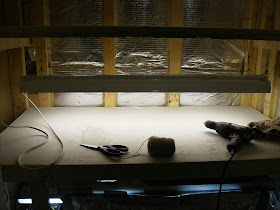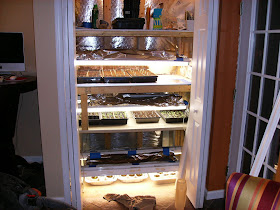Years ago Google had KNOLs. It was were you could write articles. I did that for a while until Google closed it. I kept the old articles here and will be updating them for 2015. This was how I set up my current grow light closet back in 2012. This was before all the videos. I used to just write articles with pictures.
Building an Indoor Grow Light Closet for Vegetable Seed Starting: Revised from 2012
Growing vegetables and flowers indoors is not difficult. You need space and light. You can create your own growing station by using standard fluorescent fixtures purchased at any home improvement store. You can use the fluorescent bulbs sold in these stores. There is no need to pay top dollar for grow lights systems or special grow light bulbs. For under $75 (in lights and fixtures), you can get a station set up in a closet or even on a shelf.
Every gardener desires more space. I recently had my basement finished, did the drywall myself, and had a grow-light closet built. It was under my stairs before construction and I had quite a bit of room. Though demoted to a closet, I love it. I needed to build a third level of lights. This article (an old KNOL) shows you how to build a basic and highly functional grow station. It is very easy to build.
Step One: Select A Space
This is how my closet looked before I started the third level of lights. There are two levels below it. I use foil to reflect light back into the seed trays. The third level of lights is going into that empty space.
You need to select a space and build a shelf like I did, buy shelf or put in an old table. Once you identify the location of you grow station you need a place where your seed trays will sit. Anything works. People even buy the plastic shelving units at home improvement centers for their grow stations. They provide plenty of shelves for hanging lights and a nice surface to hold your seed flats.
Step Two: Secure Boards For the Fluorescent Light Fixtures
I added four boards as seen below. The two boards in the middle will support lights and the others will support the drywall surface top. Now drywall isn't the best choice because it can get water damaged if there is a whole lot of excess water. Why did I use it? I have a lot left over from finishing my basement. The timbers are left over too. How you space the levels is up to you. You want enough space to work. If you use a shelving unit, most of the shelves have holes in them. You can hang the light using those holes.
In this space I will need two fluorescent fixtures to light the whole area. If you are building your station on a shelving unit or on a table that is 1/2 the size of the space I am using, you will only need to hang one fluorescent fixture. If you use a shelving unit, you will attach your lights to the shelf above it.
Step Three: Buying the Fluorescent Light Fixtures
That is the basic fixture I use. It is from a home improvement center. The fixture does not come with light tubes and it is inexpensive. I purchased the brightest basic fluorescent tubes in the same store. They also weren't expensive and I DON'T recommend buying tubes that are for growing plants. You know why? You just get charged double or triple for the same tubes. Just buy the brightest Lumen and Kelvin outputs on the fluorescent tube out there. I've done it that way for years. I have only replaced two tubes so far.
Step Four: Hanging the Fluorescent Lights
One fixture goes on the back middle timber. It is supported by tomato jute/string. I put loops on the end of the jute and can easily adjust the light height by attaching different loop levels to the hook in the fixture. Most of the lights come with chains and hooks. I seemed to have misplaced mine. You will be able to move your fixture up and down as the plants grow. Here is a basic distance for the light to the plants.
(These numbers were updated for 2015)
1-2 inches before the seeds germinate
2-4 inches after a 3-4 weeks of plant growth
You typically want about 2 inches between the plant and the bulb based on my experience if you can continually manage it. But this does vary, based on the type of bulb you use. You can get away with more distance from bulb to plant as the plant gets larger and stronger.
The next light goes in the front middle timber. This space requires two lights. The variance in brightness is due some to the bulbs but mostly to me using or not using the flash on my camera. I am a gardener, not a photographer.
Step Five: Use Foil to Reflect Light Back In
I put foil down with the reflective side up. My seed trays will get pushed back and the area in foil won't be fully covered by the trays. I want the light to be bounced up and around. You can also see a foil flap way in the back and on the right side. Anywhere the light goes, redirect it back to the plants with foil. Please use the reflective side. There are two fixtures in the picture below. You just can't see the one behind it.
I also have a front flap of foil attached. The growing area is now nicely wrapped in foil, mostly for maximizing light but it does help with warmth a bit too. You can see how bright the seed growing station is. It provides plenty of light without the expensive cost of grow stations.
Step Six: Various Levels of Growing Lights/Timers
The upgraded closet. I put a new shelf on the top too, to store my supplies. You can see different stages of plant growth. The bottom has seedlings in cups. The 2nd level has trays with seedling up and about and the third level is holding my tomatoes I just started a few days ago. You can start all your vegetable and flowers seeds indoors by building a basic system like this. It works. You don't need anything fancy.
I also recommend getting some light timers. It saves you the hassle of having to turn the station on and off. I typically set my timers for 14-16 hours (I used to say 10-12 hours). You can set it and forget it. You will also need some extension cords. The fluorescent lights come with 3 prongs on their plugs. You need adapters or cords the accommodate the plugs. Good Luck!
A video that explains lighting and why Lumens and Kelvin are important.
Good Luck with Your Garden, Gary (The Rusted Garden)
Join My Google+ Community Our Tomato and Vegetable Gardens (5000+ Members!)
400+ HD Short and to Point Garden Videos: My YouTube Video Gardening Channel
Follow and Organize The Rusted Garden on Pinterest









No comments:
Post a Comment
Visit The Rusted Garden's YouTube Video Channel
Follow The Rusted Garden on Pinterest